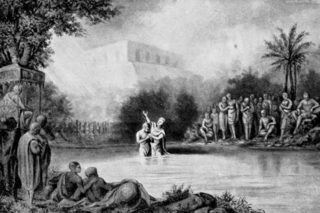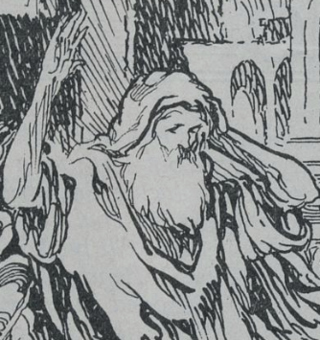The Book of Mosiah is one of the books which make up the Book of Mormon. The title refers to Mosiah II, a king of the Nephites at Zarahemla. The book covers the time period between ca 130 BC and 91 BC, except for when the book has a flashback into the Record of Zeniff, which starts at ca 200 BC, according to footnotes. Aside from stating that it was abridged by Mormon, the text says nothing about its authorship. Mosiah is twenty-nine chapters long.
The Book of Omni is one of the books that make up the Book of Mormon, a text that the Latter Day Saint movement regards as scripture. The book is written as the combined composition of several authors, the first of whom, Omni, provides the name of the book. According to the narrative, the book covers more than two centuries of Nephite history within one chapter of text. It refers to wars between the Nephites and Lamanites, the reign of Kings Mosiah and Benjamin, and their participation in the wars and journeys through the wilderness.
The Words of Mormon is one of the books that make up the Book of Mormon, a text that is held sacred in the Latter Day Saint movement. It consists of a single chapter of eighteen verses and is the only book in the text which is not titled as a "book." According to the text, it is a comment inserted by the prophet Mormon while compiling the records which became the Book of Mormon.

In the Book of Mormon, the Lamanites are one of the four peoples described as having settled in the ancient Americas in the Book of Mormon. The Lamanites also play a role in the prophecies and revelations of the Doctrine and Covenants, another sacred text in the Latter Day Saint movement.

Zarahemla is a land in the Book of Mormon that for much of the narrative functions as the capital of the Nephites, their political and religious center. Zarahemla has been the namesake of multiple communities in the United States, has been alluded to in literature that references Mormonism, and has been portrayed in artwork depicting Book of Mormon content.

Alma is a Nephite prophet in the Book of Mormon. Initially a priest who serves in the court of King Noah, when a prophet named Abinadi preaches to the court Alma concurs with Abinadi and affirms that what the prophet said is true. For this, Noah banishes Alma and tries to have him killed. After leaving the court, Alma goes on to found a church among Noah's subjects. He eventually leads these churchgoers out from Noah's lands, through a sojourn under Lamanite rule, and to the land of Zarahemla, where their ancestors had come from a few generations earlier, where Alma becomes high priest of the Nephites' church.

King Noah is a Nephite king in the Book of Mormon who appears in the Book of Mosiah. Noah rules over a colony of Nephites who come from Zarahemla and settle in the land of Lehi-Nephi, succeeding his father, Zeniff. In the Book of Mosiah, King Noah distances from his father's teachings, committing what the text calls "all manner of wickedness." Noah and his priests sentence a prophet named Abinadi, who prophesies of his kingdom's downfall if they did not repent, to death by fire. During a Lamanite invasion, Noah and some of his people flee the land, and those who remain are subjected to Lamanite control. Noah attempts to forbid his men from returning to their families, and they burn him at the stake. Noah is succeeded by his son, Limhi.

In the Book of Mormon, Limhi is the third and final king of the second Nephite habitation of the land of Lehi-Nephi. He succeeds his father, Noah. Led by Ammon, Limhi and his people escape from the Lamanites with his people to the land of Zarahemla.

In the Book of Mormon, chapters 9 through 22 of the Book of Mosiah are identified as the Record of Zeniff. These chapters contain the story of a group of Nephites, led by Zeniff, who leave the land of Zarahemla and return to their former land, known as the land of Nephi, which was then occupied by the Lamanites, their traditional enemies. Although the attempt to establish themselves among the Lamanites is successful for a short time, the people of Zeniff are ultimately enslaved and forced to pay tribute to the Lamanite king. They are later rescued by an expedition from Zarahemla sent to discover their fate. The Record of Zeniff records the reigns of Zeniff, his son Noah and grandson Limhi. The timespan is approximately 75 years.
This article is a list of rulers in the Book of Mormon, including kings and chief judges among the Lamanites, Nephites, and Jaredites.

According to the Book of Mormon, the plates of Nephi, consisting of the large plates of Nephi and the small plates of Nephi, are a portion of the collection of inscribed metal plates which make up the record of the Nephites. This record was later abridged by Mormon and inscribed onto gold plates from which Joseph Smith translated the Book of Mormon after an angel revealed to him the location where the plates were buried on a hill called Cumorah near the town of Palmyra, New York.

According to the Book of Mormon, Amaleki was one of several Nephite record keepers who maintained records on metal plates known as the plates of Nephi. The Book of Mormon refers to the small plates of Nephi and the large plates of Nephi. Nephi began writing on the small plates about 570 BC. Nephi's brother Jacob and his descendants began keeping records of sacred and religious matters on the small plates around 544 BC. Seven of Jacob's descendants, including Amaleki, wrote on the plates. Amaleki recorded his account on the plates about 130 BC. He states at the end of his writings that the plates are full. He received the plates of Nephi from his father Abinadom and penned 18 verses in the Book of Omni. He was the last person to write in the small plates of Nephi. Having no descendants, Amaleki gave the small plates to King Benjamin.
This chronology outlines the major events in the history of the Book of Mormon, according to the text. Dates given correspond to dates in the footnotes of the Church of Jesus Christ of Latter-day Saints edition of the Book of Mormon and to a Jaredite timeline proposed by Latter-Day Saint scholar John L. Sorenson.

In the Book of Mormon, Mosiah, King Benjamin's son and Mosiah I's grandson, is king of the Nephite nation from about 124 BC to 91 BC. The Book of Mosiah is named after Mosiah. Mosiah is also a prophet and is described by Ammon as a "seer" who can translate records.

The Amalekites, in the Book of Mormon, are a group of Native American dissenters from the Nephites around 90 B.C. They are after the order of Nehor and therefore believe that there will not be a Messiah and repentance is unnecessary, so when Nephite missionaries come preach to them, only one Amalekite coverts. They also press the Lamanites to war against the Nephites multiple times and participate in the destruction of Ammonihah.

In the Book of Mormon, Ammon is a Mulekite descendant and leader of a Nephite expedition from Zarahemla, sent to discover the fate of Zeniff and his people. Zeniff and his followers left Zarahemla and travelled to Nephi, their ancestral home, which was then in the possession of the Lamanites. This may have contributed to his expedition, not knowing the actual route to Nephi.

The following outline is provided as an overview of and topical guide to the Book of Mormon:

According to the Book of Mormon, Coriantumr (/ˌkɒriˈæntəmər/) was a Nephite dissenter and Lamanite captain. Coriantumr led the Lamanite armies against the Nephites in an attempt to conquer the land. He was countered by Moronihah and Lehi, eventually dying in battle.







